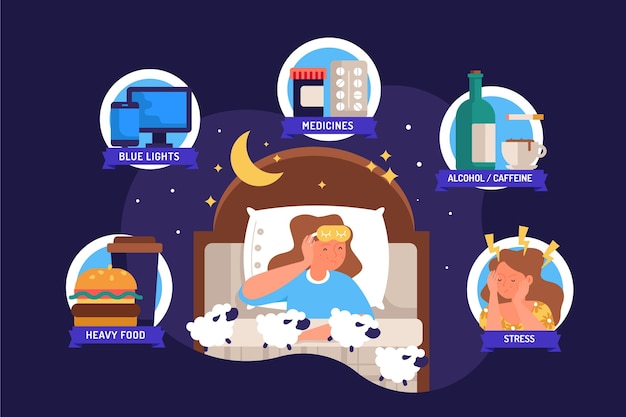
Sleepwalking, also called somnambulism, happens when a person gets up and walks around while still asleep. This condition is more common in children and often disappears as they grow older. However, if it becomes frequent, treatment might be necessary to address the issue.
When someone sleepwalks, they move from a deep sleep to a lighter or semi-awake state but remain unaware of their actions. They may seem unresponsive if spoken to and, if they do speak, it’s usually incoherent. Sleepwalkers typically don’t remember the episode when they wake up. Even though their eyes are open and appear to be staring, they don’t register what’s happening around them. Attempts to stop or interact with them often fail.
Various factors can trigger sleepwalking, such as alcohol consumption, certain medications, sleep deprivation, or illnesses like fevers. While it’s not typically linked to underlying health or psychological disorders, frequent sleepwalking in adults could indicate a deeper issue that requires medical attention. In some cases, sleepwalking can be dangerous, as the individual might unknowingly hurt themselves during an episode.
### Common Symptoms of Sleepwalking
Sleepwalking can present itself in several ways. A sleepwalker’s eyes are often wide open, giving them a vacant, staring look, and they might wander quietly or behave agitatedly, depending on their circumstances. Some may even attempt to escape a space or run anxiously. These behaviors can vary with each sleepwalking episode, and the person usually has no recollection of them afterward.
Children might feel embarrassed if they become aware of their sleepwalking. Research shows that children between ages 4 and 5 are more prone to restless sleep, which can persist into nighttime waking and sleepwalking episodes. Interestingly, many of these children don’t have pre-existing sleep disorders or a fear of the dark.
### Common Triggers and Causes
Sleepwalking can arise from various causes, affecting both children and adults. In many cases, children outgrow it during their teenage years, but some continue to experience it into adulthood.
– **Stress**: High stress levels can disrupt sleep, causing nighttime awakenings that may lead to sleepwalking. This happens unconsciously, and the person has no memory of it the next day.
– **Fever**: Severe fevers can affect the brain, resulting in disorientation and sleepwalking.
– **Sleep Deprivation**: A lack of proper sleep can confuse the brain, leading to episodes of sleepwalking.
– **Irregular Schedules**: Changes in routine, such as shift work or excessive travel, can disrupt sleep patterns and trigger sleepwalking.
– **Breathing Issues**: Sleep apnea and other conditions causing sleep disturbances can result in restlessness and nighttime wandering.
– **Genetics**: Sleepwalking may run in families. If a parent experienced it, their child is more likely to develop it.
– **Other Health Issues**: Conditions like acid reflux, Restless Leg Syndrome, and physiological changes (e.g., pregnancy or menstruation) may contribute to sleepwalking. Disorders like anxiety, PTSD, and nighttime seizures can also be related.
– **Certain Medications**: Drugs for allergies, psychiatric disorders, or sleep aids can sometimes cause sleepwalking as a side effect.
– **Alcohol**: Overconsumption can impair mental functioning, triggering sleepwalking episodes.
### How Sleepwalking Is Treated
Though there is no one-size-fits-all treatment for sleepwalking, doctors can recommend approaches tailored to the individual. For children, the condition often resolves naturally without intervention. For adults, it’s vital to identify and address potential causes, as persistent sleepwalking can disrupt daily life and even lead to harm.
Improving sleep hygiene is a simple yet effective step. Ensuring a clean and comfortable sleeping environment, maintaining a consistent sleep schedule, and addressing sleep deprivation can make a big difference.
It’s essential to share all symptoms and health concerns with a doctor, as this information helps uncover the root cause and determine the best course of action. If medications are the trigger, discussing alternatives with a healthcare provider is key.
### Preventing Accidents During Sleepwalking
For safety, family members should take preventive measures, such as keeping sharp objects like scissors and knives out of reach. It’s also important to lock windows and doors to prevent anyone from wandering outside, which could lead to accidents.
### Medical Treatments
In some cases, doctors may prescribe medications such as benzodiazepines or antidepressants, which help reduce anxiety and improve sleep quality. Commonly used medications include Estazolam, Trazodone, Clonazepam, and Diazepam. These are typically taken for 3–5 weeks to assess their effectiveness, but they should only be used under medical supervision, as discontinuing them suddenly may result in symptoms returning.
### Hypnosis Therapy
Hypnosis is another popular treatment, helping patients achieve deep relaxation and gain awareness of their sleepwalking habits. It calms their mind to promote restful sleep and enables them to recognize and control sleepwalking tendencies.
### Additional Techniques
Other approaches include relaxation exercises, mental imagery, and anticipatory awakening. For instance, caregivers can wake a sleepwalker a few minutes before their usual episode begins to break the cycle. These techniques should only be used under professional guidance.
### Final Thoughts
Sleepwalking is usually harmless, especially in children, but if episodes persist into adulthood or occur frequently, it’s important to seek help. Effective treatments and preventive measures can significantly reduce episodes, ensuring better safety and overall quality of life.